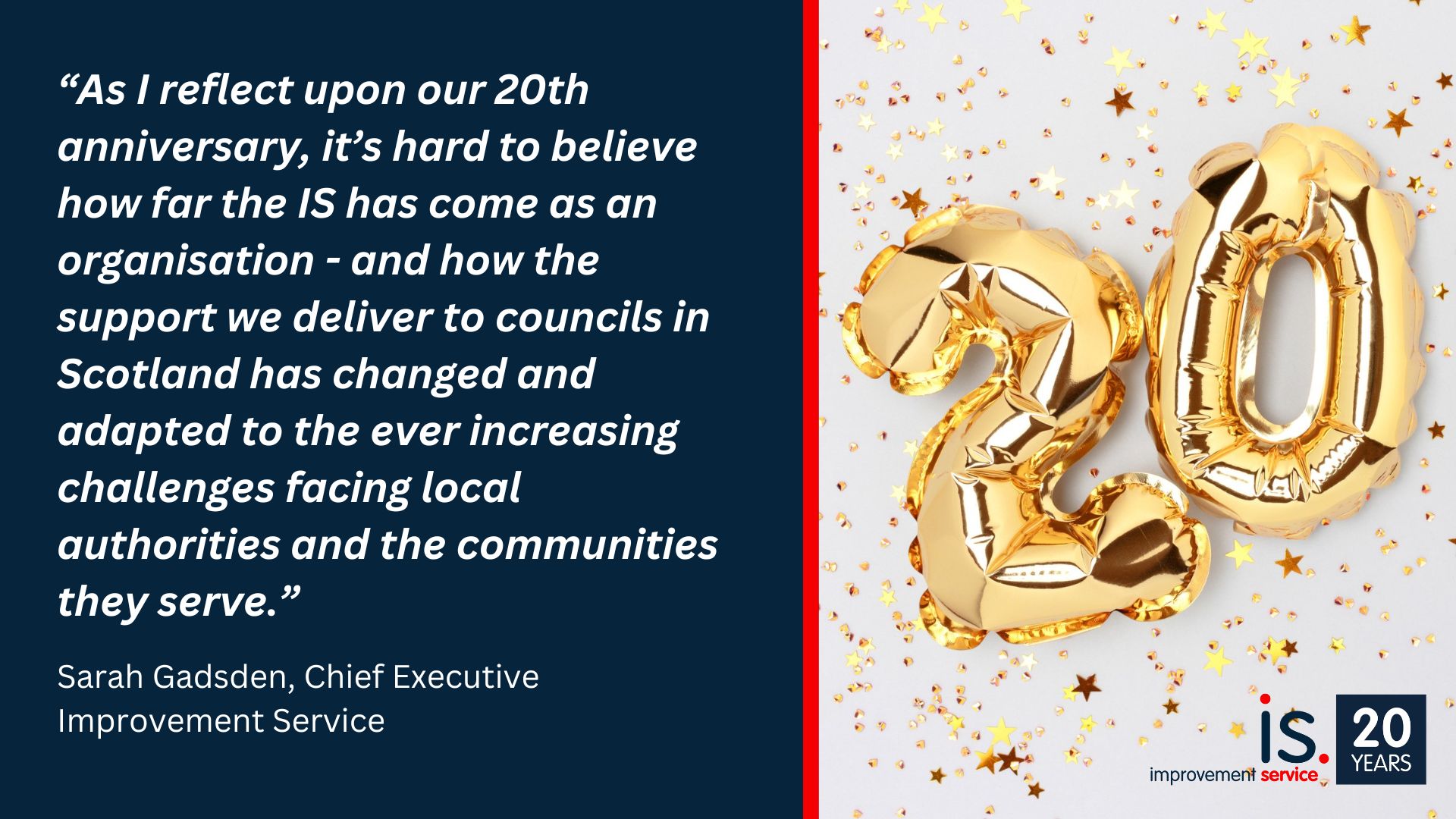
Improvement Service Chief Executive Sarah Gadsden marks the 20th anniversary of the IS by looking back at the impact the organisation has had over the last two decades.
2025 is a very special year for the Improvement Service, as we celebrate our 20th anniversary, having been incorporated on 27th July 2005. I joined the Improvement Service (or IS for short) as a Programme Manager in January 2009, when the company was only three and a half years old. I’ve had the privilege of growing alongside the IS, evolving in parallel with the organisation as it has expanded and transformed over the years.
The 16 years that I’ve been part of the IS seem to have flown by in the blink of an eye. When I joined the IS from Renfrewshire Council, I had only planned to stay for a couple of years to gain experience working at a national level. Before I knew it, those two years were up and I wasn’t quite ready to leave, so I took a vow to give myself another couple of years! However, as the years passed, I found myself continuously challenged and inspired by the work that we were delivering, and it’s fair to say, I have never once been bored in the various roles that I’ve held within the organisation. It’s been a journey of growth for me and for the IS, and I’m proud that I made the decision to stay and contribute to the organisation’s success.
The IS started its journey in 2005 with just eight employees, two of whom are still working in the organisation. By the time I joined in 2009, I must have been working with around 25 colleagues. Fast forward 16 years, and we now have 100 members of staff. Our employees are our most important asset, and our success is built on their dedication, commitment, passion, expertise and capability. IS colleagues all contribute in their own unique and valuable way, with each member of the team playing a critical role. Our strength is without doubt the sum of our parts and collective and distributed leadership is a key feature of how we work.
Our growth as a company over the last 20 years cannot be attributed to an increase in our core grant, as that has remained flat in cash terms since 2010/11. Instead, our success has been driven by our ability to grow both grant and commercial income funding streams.
We started out in 2005 with only a core grant in place through the Local Government block expenditure grant. As of 2023/24, our core grant accounted for only 14% of our total income, funding just 23.6 Full-Time Equivalent posts of our almost 100-strong workforce. Furthermore, for every £1 of core grant invested, we brought in an additional £6.68 from other sources. This achievement is a direct result of the outstanding efforts of our workforce. Our positive track record on delivery has led funders to come back to us time and again with new funding opportunities aligned with our strategic priorities, with all external funding directly supporting improvement in local government.
As I reflect upon our 20th anniversary, it’s hard to believe how far we’ve come as an organisation and how the improvement support and services that we deliver to Scottish local government have changed and adapted to the ever increasing fiscal, demographic and societal challenges facing local authorities and the communities they serve.
In 2009 when I joined the organisation, the IS was still in the early days of building trust with local authorities and helping them understand its role and our ambition to promote continuous improvement through collaboration and knowledge sharing. The IS had a limited number of products and services at that time, and a big priority was to foster a culture of learning across local government, to help local authorities navigate the challenges they faced, particularly in terms of achieving efficiencies and improving service quality and customer satisfaction. Although we were still at the very early stages of supporting local government to become more effective and responsive, I had no doubt within the first few months of being an IS employee that we were poised to make a meaningful difference.
In the early days of my IS career, I was tasked with developing and delivering our elected member development programme to support elected members in their critical governance role. This included developing national induction notebooks for elected members, which have been adapted over the years but are still in place and very much used today along with a Continuous Professional Development Framework for Elected Members, which has now morphed into a Political Skills Framework. Today we continue to add value to the work individual local authorities undertake on elected member development, through the delivery of national briefings and guidance, webinars and workshops, coaching, political mentoring programmes and other learning resources which councils can use locally to help increase members’ knowledge of issues, or which members can use themselves as part of self-directed learning.
I was also heavily involved in supporting the Public Service Improvement Framework (PSIF) around the same time that the Accounts Commission launched Best Value 2, which included a requirement for local authorities to evidence that they were using self-evaluation. My phone became a hotline for several months, with local authorities’ keen to sign up to PSIF! Although PSIF has been through various iterations over the years, it remains a core improvement offering, helping local authorities to evidence Best Value and improvement activity to auditors, inspectors and regulators.

Another key element of our core improvement offering is the Local Government Benchmarking Framework (LGBF), which was launched in 2013, bringing together a wide range of information about the performance of all Scottish councils. The LGBF helps councils compare their performance against a suite of efficiency, output and outcome indicators that cover all areas of local government activity. This sector-led improvement approach has successfully supported all 32 Scottish local authorities to work and learn together and continues to do so to this day.
The early days of the IS were very much focused on the company establishing its core improvement offer. However, it wasn’t long before we started to expand, with the integration of the externally funded Customer First Programme and the receipt of specific grant funding to deliver a Planning Development Programme and national shared services programme.
A few years into my journey with the IS, I remember we agreed to take on the Scottish Government’s national violence against women programme. In 2025, we are still in receipt of grant funding for this programme, which has also expanded its remit to include work on trauma informed practice. In the 16 years I’ve been in the IS, we have consistently secured grant funding year-on-year to support local authorities and partners with improvement work in interconnected policy areas including child poverty, rights-based approaches, welfare advice and health partnerships, early learning and childcare, public service reform, climate change, planning improvement, place-based approaches, employability and community wealth building, to name but a few. I believe our success in securing grant funding can be attributed to a combination of our ability to respond quickly and with agility, to deploy and adapt our well-established improvement architecture in different service areas, and our proactive, solution-focused approach to everything we do.
Digital enabled transformation has been a core element of the work of the IS since 2006, when the national Customer First programme was integrated into the IS. It is probably not widely known that myjobscotland, the national shared recruitment portal for all 32 local authorities and key partners which is delivered by COSLA, began life in the IS. We launched the portal in 2009, and it later transferred to COSLA given their role as the Employers’ Organisation. In 2010, we entered into a Revenue Support Grant Agreement with the Scottish Government, to deliver a range of services including a national Citizen Account system, a National Entitlement Card and a National Gazetteer service. Four years later, we launched the mygovscot myaccount service, supporting citizens to access a range of online public services with one username and password. Our mygovscot myaccount platform is used by all 32 local authorities and a range of partners and has now reached over 2.6 million users, over 50% of the eligible population (12 years +).
In July 2020, we launched getyournec.scot, for National Entitlement Card applications, which uses the mygovscot myaccount platform to provide secure authentication and identity verification, ensuring that the online system is as robust as in-person applications. This was used to support the delivery of the Scottish Government’s Young Person’s Free Bus Travel Scheme, where we helped local authorities save over £4m in processing applications and delivered £13 in benefits for every £1 invested.
In 2017, building on our success with the delivery of the One Scotland Gazetteer, we launched the Spatial Hub to improve the management of spatial information across local government. We were pleased to be able to launch open access to the Spatial Hub in summer 2023, the first time in the UK that such a significant geospatial resource has been made available as open data.
Our portfolio of national digital public services has grown over the last few years, minimising the need for local authorities to develop their own digital solutions or procure, install, maintain and fund solutions, thereby generating savings and efficiencies. I have every confidence that our portfolio will continue to grow exponentially over the coming years, as citizens continue to demand more convenient, accessible and user-friendly digital interfaces with their local authority, whilst local government is under increasing pressure to reduce costs and duplication. Looking forwards, 2026 will be a momentous year as we launch our new national visitor levy platform, which we’re currently co-designing with the early adopter local authorities.
Hopefully by now you’ll have a sense of the type of organisation we are, the journey we’ve been on, and the contribution we have made - and continue to make - to Scottish local government and its many partners. I’ll finish with an area of work that is close to my heart, and that is the transformation programme that we are supporting Solace Scotland to deliver. We launched a think piece at the Solace Scotland conference in September 2022, on Delivering a Future for Scottish Local Authorities, which we authored in partnership with seven local authority Chief Executives. This was a landmark moment for us, with the seven Chief Executives personally committing to the programme of transformation set out in the think piece and inviting their peers to join them on that journey. Nearly two and a half years later and following a ‘call to action’ for local government volunteers, we have a dynamic, exciting, purposeful and value driven transformation programme underway in partnership with Solace, with Chief Executives committing resources to support the delivery of this important and impactful work. Watch this space!
As I draw this blog to a close, it would be remiss of me not to recognise the contribution of former employees and Board members, some of whom are sadly no longer with us, for their role in helping to make the IS what it is today. I also want to take a moment to express my gratitude to my IS colleagues for their dedication, hard work and contributions which have played a huge and vital role in our successes – it is most certainly a ‘Team IS’ effort. I would also like to thank our Board members for their support, direction, encouragement and constructive challenge, which are critical to ensuring we deliver what local government needs. Together we will continue to uphold our responsibility as custodians of the IS, ensuring its legacy for generations to come.